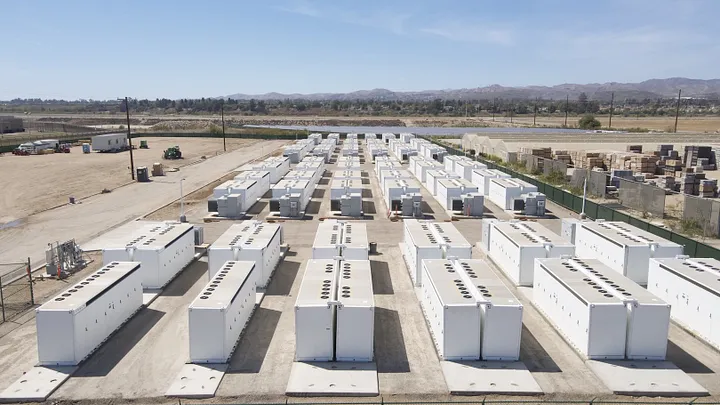 Saticoy energy storage facility. Photo: Arevon Asset Management
Saticoy energy storage facility. Photo: Arevon Asset ManagementAs long as power generation is dominated by fossil fuels, electricity from grid-connected solar farms or wind farms usually does not go to waste; even when generation from renewables is (temporarily) high, it is still consumed in full; this is balanced by burning a little less natural gas or coal. However, as you decrease the share of fossil fuels and get closer and closer to an all-renewables grid, you will soon encounter a problem: the problem of energy storage, because supply (generation from solar and wind) does not want to follow the demand.
If you cannot store that excess green electricity somewhere, to be used later when power generation from renewables is low, the gap in supply will be filled by fossil fuels. Companies investing in solar farms will be happy (because they will hold a large share of the market), fossil fuel companies will be happy (because they will still hold a large share of the market), but pumping CO2 into the atmosphere will continue.
California’s solution to the storage problem is to use a lot of batteries. Not something analogous to batteries, but actual batteries — of the kind that, two decades ago, were not commonly used is anything bigger than a laptop.
If it’s stupid but it works…
It is not the first time that some low-CO2 technology seems too impractical to be deployed on a large scale, and then actually gets deployed on a large scale.
For example: are electric cars feasible? The energy density of Li-ion batteries is like 10–20 times lower than usable energy density of gasoline (and that is after correcting for the gasoline engine’s low efficiency). So, naturally, an electric car, with its batteries weighing 10–20 times more than the contents of a normal car’s fuel tank, would be prohibitively heavy.
And are electric cars a real thing in 2022? Yes, they are.
Now let’s imagine an electricity grid that relies not on fossil fuels, not on nuclear, not on hydro, but on solar and wind; mostly solar. Sources which are, obviously, intermittent. How do you get a steady, reliable stream of electricity from sources that are simply not steady? If the prevailing energy source is solar, not wind — and the sun disappears only for hours, not days — how about a partial solution: batteries that can power the grid for a few hours — just a few hours, not the whole night — after sunset?
Batteries than can power the grid. Not a long time ago, the whole idea would have been laughed off, but California is already 2.5 GW past laughing. This is how much utility-scale battery storage CAISO had at the end of 2021. The overwhelming majority of it was installed during 2021. CAISO is the operator serving about 80% of California’s population.
It would be interesting to see how much battery storage California has in terms of GWh (so the total capacity — not the maximum power output).
And according to CAISO’s website, the California Public Utilities Commission’s draft preferred system plan calls for 12,000 MW [12 GW] of installed utility scale batteries by 2025.
Who’s next?
There are alternatives to battery energy storage, one of the most obvious ones being the dispatchability of hydropower. So, lessons from California should matter especially to countries/regions which cannot use the second option — because they have a low share of hydropower in overall electricity generation but good conditions for solar power. Like Australia.
China, on the other hand, does have a lot of hydroelectric capacity and is adding more (with just two recent projects, Baihetan and Wudongde, adding 26 GW of hydro capacity overall), which can be used to smooth out the intermittency of solar and wind. But still, it has laid out an ambitious plan to add gigawatts of battery storage in the coming years.
___
Source: [1]